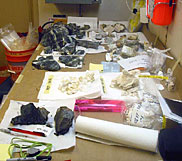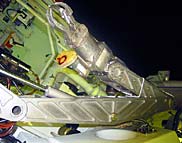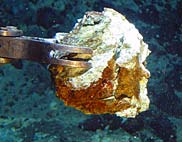|
|
|||||||||||||||||||||||||||||||||||||||||||||||||||||||||||||||||||||||||||||||||||||||||||||||||||
 |
|||||||||||||||||||||||||||||||||||||||||||||||||||||||||||||||||||||||||||||||||||||||||||||||||||
Just taking them to the bottom of the ocean isn't enough, the scientists want to bring the seafloor back with us...Not an unreasonable request when you consider that Lost City was discovered in December of 2000, and it has taken them this long to get back out, and get back down. Debbie and Jeff (the chief scientists) had one dive to look at Lost City, which is about 400 square meters, on a cruise dedicated to characterizing the Atlantis massif, an area of about 400 square miles. They were able to collect a few samples, really just enough to prove they needed more. So for the last two years they have been wondering what kind of rock lies under the white carbonate, and what the chemistry of the fluids building the spires really is. That's where the Alvin comes in. We take them down, and we haul it all up. So far this cruise, which still has three dives to go, Alvin has collected 98 rock samples, 35 of them from the hydrothermal chimneys. The water chemists have 78 water samples recovered by Alvin. In case they can't remember what something looked like, they have over 200 hours of video and about 1500 still pictures from hand-held cameras. Add to that around 40,000 images from the Alvin's two electronic still cameras. I'm afraid to start counting the data byte for byte, but just imagine a really, really big number. The biologists have bags and bags of animals in the freezer and a whole shelf full of sample vials. I tried to ask the microbiologists how many bacteria we had collected but they were huddled under a blanket in the corner of the lab, mumbling "Please stop...No more, no more!"
The Pilot's part in this business is the best. I get to look out the viewport, drive the sub, and use the manipulator to pick up rocks. Cool. Of course, I'm expected to know a little bit, like how every single piece of gear on the sub works and what to do if it breaks. And enough about geology to get the right lumps for the Rock-Docs. And enough about biology to get the right animals for the Bug-Hunters. A good Alvin Pilot has to understand enough of the science to ensure the scientists get what they want. Otherwise, the dive is just a fun ride to the bottom of the ocean, with no knowledge gained.
Let's put you in the Pilot's place. A typical rock sampling goes something like this. Alvin is on the seafloor, at 800 meters, floating beside a sheer cliff of hard black rock. Look down and the light just fades out...this cliff is hundreds of meters tall, there is effectively no bottom below you. Drop a valuable sample, or a $10,000 titanium water bottle, and it's gone forever. Look up and the cliff stretches away into darkness. That's OK, what you don't want to see is a rock poised above your head, ready to slide down on top of Alvin. Now you can look at the cliff. It is smooth and unmarked. Very pretty, but nowhere to grab a sample. Alvin's manipulator needs an outcrop or crack to get its claw around. So you drive the sub along the wall by bending the propulsion joystick to the left. After a few moments the Port Scientist points out a place where the rock is streaked with yellow, where a fault or channel water has flowed through. Great, as long as there is something to grab. Stop driving before you go past it, and remember that Alvin might be floating, but it still has 36,000 lbs of mass to stop. Work on that a while as you get into position. Did you remember to check which way the current was flowing? No? You are about to find out, and hopefully it will not be strong enough that you have to move the sub to take the sample. Start up the hydraulic system, then the Port Manipulator. Now you are controlling a six foot long titanium arm capable of lifting 250 lbs at full extension by using a foot long plastic arm as you kneel in the cold dark sub. Reach out and touch the wall, see if the claw can get a grip on anything. If so, is it the rock the scientist wants? If not, reposition.
But let's say you knew enough and gripped the right rock, and that it was loose while still being in place on the vertical cliff. Lucky. You pick it up and hold it over Alvin's science basket so if it does drop, it isn't gone into the abyss. Smart. The scientists begin talking into their voice recorders and getting good video of the sample and where it was pulled from the wall. Almost done. You take a couple still images with the hand held digital cameras. You then set the rock down gently in the area of the basket the scientists tell you, then stow the manipulator. Elapsed time, about 5 minutes if all goes well. Back on deck the sun is shining, and you get to stand up straight for the first time in 7 hours. Your knees are numb, your socks are damp, and your back is sore, but you have a basket load of seafloor for the scientists. They will act all excited, weighing and handling the rocks, cataloguing each one, naming it with the dive number and the time it was collected. Then they take hammers and saws and chop and pound it to bits so several of them can take their own piece home. And the Pilot? Get a cup of coffee, fix whatever didn’t work as it should have on the sub, and get to bed cause tomorrow at 6AM you have to get up and get Alvin ready to dive again. If you're lucky, and work real hard, it never stops. |
|||||||||||||||||||||||||||||||||||||||||||||||||||||||||||||||||||||||||||||||||||||||||||||||||||




